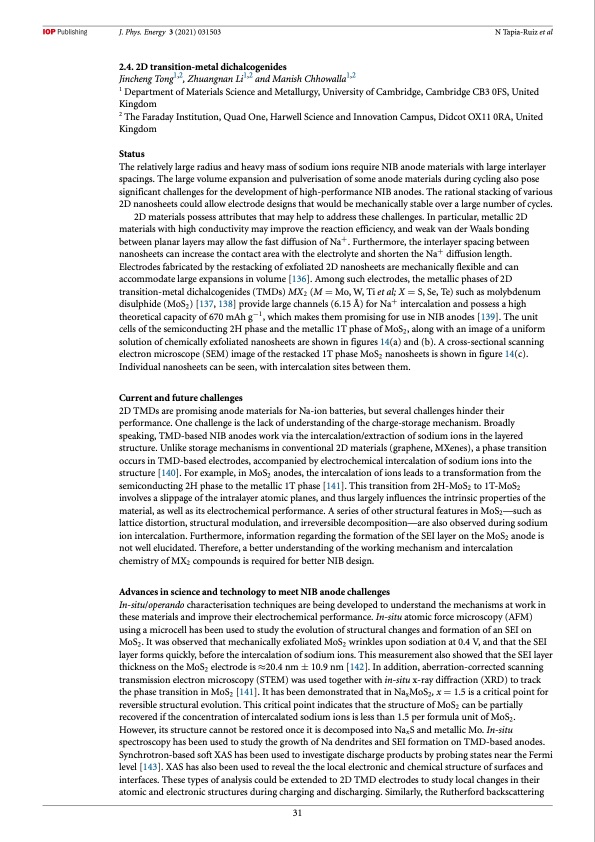
PDF Publication Title:
Text from PDF Page: 032
J. Phys. Energy 3 (2021) 031503 N Tapia-Ruiz et al 2.4. 2D transition-metal dichalcogenides Jincheng Tong1,2, Zhuangnan Li1,2 and Manish Chhowalla1,2 1 Department of Materials Science and Metallurgy, University of Cambridge, Cambridge CB3 0FS, United Kingdom 2 The Faraday Institution, Quad One, Harwell Science and Innovation Campus, Didcot OX11 0RA, United Kingdom Status The relatively large radius and heavy mass of sodium ions require NIB anode materials with large interlayer spacings. The large volume expansion and pulverisation of some anode materials during cycling also pose significant challenges for the development of high-performance NIB anodes. The rational stacking of various 2D nanosheets could allow electrode designs that would be mechanically stable over a large number of cycles. 2D materials possess attributes that may help to address these challenges. In particular, metallic 2D materials with high conductivity may improve the reaction efficiency, and weak van der Waals bonding between planar layers may allow the fast diffusion of Na+. Furthermore, the interlayer spacing between nanosheets can increase the contact area with the electrolyte and shorten the Na+ diffusion length. Electrodes fabricated by the restacking of exfoliated 2D nanosheets are mechanically flexible and can accommodate large expansions in volume [136]. Among such electrodes, the metallic phases of 2D transition-metal dichalcogenides (TMDs) MX2 (M = Mo, W, Ti et al; X = S, Se, Te) such as molybdenum disulphide (MoS2) [137, 138] provide large channels (6.15 Å) for Na+ intercalation and possess a high theoretical capacity of 670 mAh g−1, which makes them promising for use in NIB anodes [139]. The unit cells of the semiconducting 2H phase and the metallic 1T phase of MoS2, along with an image of a uniform solution of chemically exfoliated nanosheets are shown in figures 14(a) and (b). A cross-sectional scanning electron microscope (SEM) image of the restacked 1T phase MoS2 nanosheets is shown in figure 14(c). Individual nanosheets can be seen, with intercalation sites between them. Current and future challenges 2D TMDs are promising anode materials for Na-ion batteries, but several challenges hinder their performance. One challenge is the lack of understanding of the charge-storage mechanism. Broadly speaking, TMD-based NIB anodes work via the intercalation/extraction of sodium ions in the layered structure. Unlike storage mechanisms in conventional 2D materials (graphene, MXenes), a phase transition occurs in TMD-based electrodes, accompanied by electrochemical intercalation of sodium ions into the structure [140]. For example, in MoS2 anodes, the intercalation of ions leads to a transformation from the semiconducting 2H phase to the metallic 1T phase [141]. This transition from 2H-MoS2 to 1T-MoS2 involves a slippage of the intralayer atomic planes, and thus largely influences the intrinsic properties of the material, as well as its electrochemical performance. A series of other structural features in MoS2—such as lattice distortion, structural modulation, and irreversible decomposition—are also observed during sodium ion intercalation. Furthermore, information regarding the formation of the SEI layer on the MoS2 anode is not well elucidated. Therefore, a better understanding of the working mechanism and intercalation chemistry of MX2 compounds is required for better NIB design. Advances in science and technology to meet NIB anode challenges In-situ/operando characterisation techniques are being developed to understand the mechanisms at work in these materials and improve their electrochemical performance. In-situ atomic force microscopy (AFM) using a microcell has been used to study the evolution of structural changes and formation of an SEI on MoS2. It was observed that mechanically exfoliated MoS2 wrinkles upon sodiation at 0.4 V, and that the SEI layer forms quickly, before the intercalation of sodium ions. This measurement also showed that the SEI layer thickness on the MoS2 electrode is ≈20.4 nm ± 10.9 nm [142]. In addition, aberration-corrected scanning transmission electron microscopy (STEM) was used together with in-situ x-ray diffraction (XRD) to track the phase transition in MoS2 [141]. It has been demonstrated that in NaxMoS2, x = 1.5 is a critical point for reversible structural evolution. This critical point indicates that the structure of MoS2 can be partially recovered if the concentration of intercalated sodium ions is less than 1.5 per formula unit of MoS2. However, its structure cannot be restored once it is decomposed into NaxS and metallic Mo. In-situ spectroscopy has been used to study the growth of Na dendrites and SEI formation on TMD-based anodes. Synchrotron-based soft XAS has been used to investigate discharge products by probing states near the Fermi level [143]. XAS has also been used to reveal the the local electronic and chemical structure of surfaces and interfaces. These types of analysis could be extended to 2D TMD electrodes to study local changes in their atomic and electronic structures during charging and discharging. Similarly, the Rutherford backscattering 31PDF Image | 2021 roadmap for sodium-ion batteries

PDF Search Title:
2021 roadmap for sodium-ion batteriesOriginal File Name Searched:
roadmap-sodium-ion-batteries_031503.pdfDIY PDF Search: Google It | Yahoo | Bing
Salgenx Redox Flow Battery Technology: Salt water flow battery technology with low cost and great energy density that can be used for power storage and thermal storage. Let us de-risk your production using our license. Our aqueous flow battery is less cost than Tesla Megapack and available faster. Redox flow battery. No membrane needed like with Vanadium, or Bromine. Salgenx flow battery
| CONTACT TEL: 608-238-6001 Email: greg@salgenx.com | RSS | AMP |